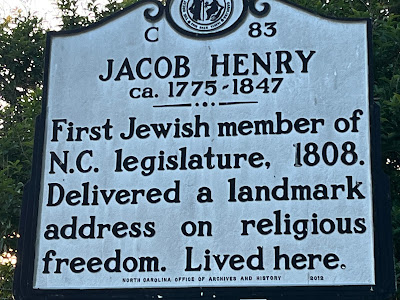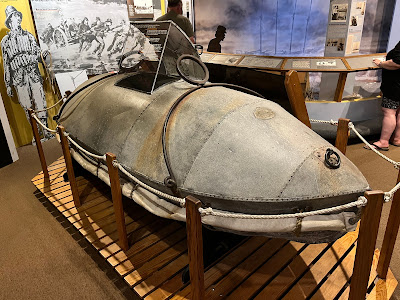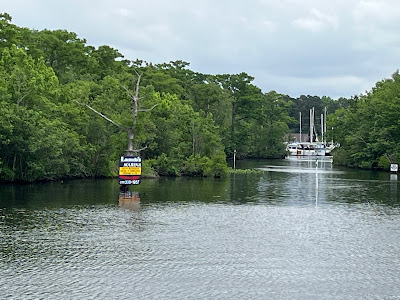Thursday, June 16, 2022
The Great Dismal Swamp
My last blog post had us leaving our anchorage at Marine base Camp Lejeune, N.C to the seranade of live fire practice from the base. We continued on from there to Beaufort, N.C. To clear up a little confusion... we were previously in Beaufort, S.C. but to add to the confusion... in N.C. the city is pronounce "Bowfort" as opposed to the "Byoufort" in S.C. The current runs through the marina here quite strong so and we had to back in to a rather tight slip. It wasn't pretty but we got in without any damage or too much screaming. We are getting better at this! We met up again with our friends on "Start Dust" who were in the slip next to us. Shortly after we arrived, a beautiful 72' sport fisher pulled in that was being delivered from its winter home in Florida to its summer home in New Jersey. The crew ran the boat overnight from St. Augustine, Florida to Beaufort where they came in to refuel. They loaded on 2,000 gallons of fuel. Can you imagine... $12,000 for fuel for 1 day?
Like many of the towns we have been through, Beaufort had a waterfront street wTth shops, restaurants and a maritime museum. There were many beautiful old homes dating back to the mid 1700's.On display in the window of one of the old homes was the leg lamp made famous in the classic movie, "A Christmas Story." The town also had a number of old cemetaries with gravestones telling the historical stories of the civil war and the general difficulties of life in the 18th century. So many children dying young and mothers dying shortly after giving birth. We also toured the Beaufort Maritime Museum where we learned of the areas rich history of shipwrecks and pirates, including the famous Blackbeard. The museum housed a number of unique rescue capsules that shipwrecked sailors and passengers could be sealed inside of so they could be hauled to shore.
From Beaufort we headed up the Neuse River to River Dunes which couldn't have been any more differnt from the old towns we had been visiting. River Dunes is newer private enclave of homes in a planned community. As we relaxed in the pool and had dinner in the club house, Karen declared she could move there. We borrowed bikes to tour the area and I started to get a bit creeped out. It was almost too perfect.. Kind of like the film, "Stepford Wives", I couldn't help but wonder what kind of secrets they were hiding under this well manicured exterior!
Our next stop was Belhaven, N.C. An uneventful trip overall. We had dinner there with our friends Katja and Swen at Spoon River Restaurant. This upscale restaurant seemed a bit out of place in this small southern community. Swen and I thoroughly enjoyed our meals.... unfortunately, Karen and Katja were not so impressed with theirs. Other than this the only thing memorable about Belhaven was how rough it was on our dock. We were rocking all night like we were in a magnitude 7 earthquake. In the morning we found one of our docklines had worn almost all the way through!
We left the next morning for another 50 mile run to Allligator River Marina. This small marina, is associated with a road side gas station that also happens to sell phenominal southern fried chicken. How could we resist? That evening we got together with the couples from "Mirth", "Heliopause" and "Start Dust" for a pleasant round of docktails and conversation. Alligator River Marina is at the southern end of the Albermarle Sound and serves as a staging ground for boaters needing to cross the sound. A sound is a body of water connected to a larger body of water, usually the ocean. Sounds can be hazardous as they are far more exposed than the waterways we had been travelling and the conditions can often change unexpectedly. The Albermarle is no exception to this rule and all of us at doctals that night had some nervousness at the anticipation of what might lie ahead for us in the morning. Fortunately, the weather forcast was favorable. We set out the next morning with calm winds and flat seas and the conditions remained that way for our entire run across the sound and up the Pasquotank River to Elizabeth City and Lambs Marina. Along the way we did have to dodge crab traps, avoid a sunken sailboat and we saw a huge hanger like structure that we later came to find out was built to construct airships (blimps). Once we passed under the drawbridge at Elizabeth City, we suddenly found ourselves in an entirely different world. From the open spaces and lowland marshes that we had been in we were now in a serene tree lined river.... the lead up to the Dismal Swamp. We pulled in for the night to Lambs Marina, a tiny marina that probably had not changed much for 50 or more years. The owner and residents were nice as could be but I must admit I kept wodering if there might be a toothless guy with a banjo somewhere close by. That night as I checked the sea strainers for my engine and AC water intakes, I was surprised to see them filled with tiny shrimp....hundreds of them, each maybe 1/4 to 1/2 inch long. The waters of the Albermarle must have been filled with them. At the start of my last blog, I had a teaser about the Dismal Swamp. Lambs Marina was our last stop before entering the swamp and we left the next morning with great anticipation.
THE DISMAL SWAMP:
Early surveyors and mapmakers referred to this swamp land of northeastern North Carolina and southwestern Virginia as a dismal and forbidding place and the name, "Dismal Swamp" was first noted on a map in 1733. In 1763, a 31 year old George Washington visited the area and described it as a "glorious paradise." He also saw it to be an area of great opportunity. With other investors, he formed the Dismal Swamp Land Company to purchase 60,000 acres of the swamp. This is when the history becomes dark and ugly. Slaves were ordered to dig a canal with the intention of draining the swamp for farming. When this proved unprofitable they turned to lumber and shingle production and the canals were used to transport the lumber out of the swamp. The digging of the swamp was done under what could only be described as intolerable conditions... working in the mud in the hot and humid insect and snake filled swamp. The timber companies then used both slaves and free African-Americans to cut and gather the shingles and continue to dig the canals. They lived in camps on the banks of the canals. Some of the companies shared profits with the slaves which sometimes allowed them to purchase their freedom. This densely forested swamp area was also a cover area for slaves seeking their freedom. They would travel on foot through this area to the ports of Elizabeth City, Portsmouth and Norfolk to escape on north bound ships. Some would stop here to work for the opportunity to purchase their fredom and others, known as "Maroons" found permanent refuge here and formed colonies that lasted for mutlitple generations. The Dismal Swamp State Park is a designated site for the National Underground Railroad Network to Freedom.
The Dismal Swamp Canal is the oldest operating man made waterway in the US. In the mid 1800's, hundreds of passenger ships, shingle flat boats and schooners used the canal as a transportation route. It was also used to move supplies dring the civil war. In 1859, the Albermarle-Chesapeake Canal was constructed which led to a significant decline in traffic along the Dismal Swamp canal. Today it is part of the Intracoastal Waterway and used almost exclusively by pleasure boaters- Like Us! The area is now a North Carolina State park and serves as a protected site for plant and animal species including bobcats, black bears, otters, deer and over 70 species of reptiles and amphibians and over 200 species of birds. The tannins released by the decaying vegetation turns the water a deep black color which along with the dense foliage makes the canal both beautiful and foreboding.
As an optional path of the Atlantic Intracoastal Waterway, we chose the canal as our route from the Albermarle Sound in NC to Norfolk, Va. The 22 mile long canal is entered and exited by one lock at each end and is known for having shallow water with both floating and submerged logs and foliage that can snag and damage props. For this reason, most of the boaters along the AICW choose to avaid the swamp and instead use the Albermarle-Chesapeake canal. That canal is larger and deeper and has signicant commercial traffic. It also has a restaurant at the town of Coinjock known for serving great prime rib. But the allure of the swamp drew us to it...or may be I should say it drew me to it and I brought Karen along! We went through very slowly (4-5 miles per hour) and stayed far behind other boats in case they dislodged logs from the bottom and we made it through with only one tiny bump on the hull and no bumps on the props. In return we were rewarded with a phenominal experience. We stayed overnight on a free dock at the visitors center and took a walk through the lush forest. Unfortunately, the weather for our 2 days in the swamp was appropriately dismal (cloudy and drizzly) so we did not get to experience the dramatic contrast of black water and light blue skies, but it was beautiful nonetheless. And... the drizzly weather kept the flying insects away.
As abrupt as the change of scenery was entering the river and canal from the south, the change was even more abrupt as we exited the canal into the Elizabeth River and the entrance to Norfolk. Almost immediately, we were forced to wait for 30 minutes in the current for a railroad bridge to open and then we were hailed by a southbound freighter to stand off as they came through a bridge too narrow for both of us to pass through safely. A rude welcome back to civilization. And... a good place to stop this blog! See ya next time folks.
Subscribe to:
Posts (Atom)
Welcome to Kentucky
This Riverboat Still Cruises The Mississippi and Ohio Rivers We left Hoppie's on a chilly 42 degree morning to continue on down the Miss...

-
Hard to believe its been 17 days since our last post! Since then, we moved onto the boat, gave her her name, and were surprisingly able to f...
-
On our last post, we were heading north out of the Chesapeake Bay. The passage out is along the C & D canal. As far back as 1764, map ma...
-
A couple of years ago Karen and I were at the Long Beach Boat show looking for a small boat to use for local cruising. While waiting in ...






































